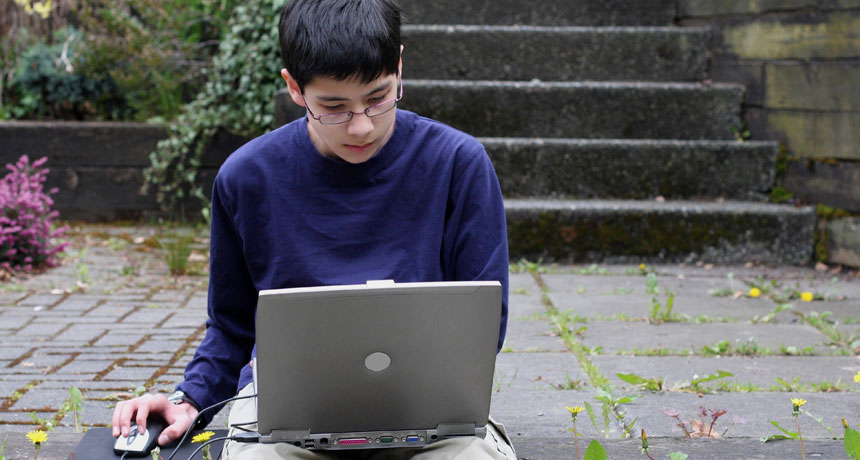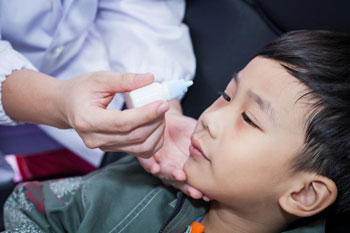Nearsighted? Eye drops slow worsening vision
Low doses of an ancient drug could slow the development of myopia

Much of the world may eventually need glasses for nearsightedness. A new drug treatment could limit the likelihood their problem will worsen — and perhaps one day lead to more serious eye problems.
beemore / iStockphoto
By Ilima Loomis
Need glasses to see across the room? You’re not alone. A global surge in myopia (My-OPE-ee-ah) means more people are nearsighted than ever before. Distant objects appear fuzzy to these people. It’s a problem that, until recently, doctors could correct only with glasses or contact lenses. Now scientists in Singapore have discovered they can protect the eyesight of severely myopic children. They have done this by using an ancient drug in a new way.
The drug is atropine (AT-troh-peen). It is a poison made by many plants in the nightshade family, such as mandrake and belladonna. These plants can be poisonous. But for thousands of years, doctors — going back to the ancient Greek and Egyptian healers — have used poisons as medicines. Drug companies today can now make atropine in the lab. This chemical has several uses as a medicine. But atropine also has uncomfortable side effects. These can include blurry vision and sensitivity to light. For that reason, it has only been used to treat severe eye problems, such as lazy eye. It has not been used for myopia, even though doctors had suspected it might help.

The scientists tested atropine at different doses. Their high doses were similar to amounts used to treat lazy eye. The very lowest doses that they used had never been tried before. And indeed, the lowest concentration, just 0.01 percent, worked best. Children who took eye drops with this concentration of atropine were the least nearsighted after five years. Compared to kids who received no atropine, the drug slowed the worsening of their myopia by around 50 percent. And at this low-treatment dose, there were very few side effects.
“We now have data showing that it is not only effective, but also safe,” says Donald Tan. He’s an ophthalmologist (Op-tha-MOL-uh-gist) at the Singapore Eye Research Institute and the National Singapore Eye Center. He led the study. Tan presented his team’s findings on November 16 at the annual meeting of the American Academy of Ophthalmology in Las Vegas, Nev.
Worldwide, myopia is increasing. Roughly 42 percent of people are myopic today. Forty years ago, only 25 percent were. The problem seems to be worse in developed Asian countries. There, as many as 90 percent of young adults may be nearsighted. Scientists believe that spending more time indoors and focusing on close objects like books and computer screens may contribute to the problem. “That’s why nerds wear glasses — it’s really true,” Tan said at a press conference.
Doctors don’t just want to treat myopia so that fewer people will need to wear glasses. A more important problem is that people with severe nearsightedness face an elevated risk of serious eye disease later in life. These ailments include detached retinas, premature cataracts and glaucoma. Such conditions can lead to blindness.
“If this drug can keep you from going as high [in myopia] as you would have gone, that’s a good thing,” says Graham Quinn. “It decreases your likelihood of problems.” Quinn is a pediatric ophthalmologist at the Children’s Hospital of Philadelphia in Pennsylvania. He was not involved with the study.
Because the drug was tested only in Asian children, Quinn says more studies would be needed to confirm that it would work as well in other populations. But he says the scientists’ achievement was in discovering that atropine works at much lower doses than had ever been used before.
To families with children who are developing myopia, “It would seem reasonable to offer this as an option,” Quinn says. “The low dose opens it up for a reasonable conversation with people.”
Power Words
(for more about Power Words, click here)
atropine A drug originally derived from plants in the nightshade family that is used to treat “lazy eye.”
cataract A vision impairment caused by a cloudiness in a membrane that covers the lens of the eye. Uncorrected, it can lead to blindness.
chemical A substance formed from two or more atoms that unite (become bonded together) in a fixed proportion and structure. For example, water is a chemical made of two hydrogen atoms bonded to one oxygen atom. Its chemical symbol is H2O. Chemical can also be an adjective that describes properties of materials that are the result of various reactions between different compounds.
glaucoma Eye disease that is the equivalent of hypertension: the pressure exerted by fluid inside the eye becomes excessively high. That pressure can damage the nerve carrying vision signals — and, if untreated, lead to partial or total blindness.
lazy eye Decreased vision, usually in one eye, that come from abnormal eye development during childhood. Over time, the brain often learns to ignore signals from the weaker eye, which often does not point in the same direction as the stronger eye.
myopia The medical term for nearsightedness. An inability to focus on anything much more than an arm’s length away.
nearsighted An inability to focus on anything that isn’t nearby. It’s due to an elongation of the eyeball. Many factors can contribute to this inappropriate elongation, and so the cause of nearsightedness is still under debate.
nightshades The Solanum family of plants that includes some 1,500 species. Among the better known foods in this group are the potato (Solanum tuberosum L.) and eggplant (Solanum melongena L.). Some herbaceous members of the family, however, can prove very toxic to animals and people. Among these are the black nightshade (Solanum nigrum), which makes the poisonous compounds atropine and solanine, and bittersweet nightshade (Solanum dulcamara), of which all parts of the plant are toxic due to their atropine, solanine and dulcamarine.
ophthalmologists Physicians who specialize in the eye. They begin as general medical doctors and then get several additional years of training on diagnoses and treatment of problems affecting the eyes. Optometrists, in contrast, are doctors but are not trained as physicians (what in the United States are known as “medical” doctors).
pediatrics A field of medicine that has to do with children and especially child health. A doctor who works in this field is known as a pediatrician.
retina A layer at the back of the eyeball containing cells that are sensitive to light and that trigger nerve impulses that travel along the optic nerve to the brain, where a visual image is formed.
Singapore An island nation located just off the tip of Malaysia in southeast Asia. Formerly an English colony, it became an independent nation in 1965. Its roughly 55 islands (the largest is Singapore) comprise some 687 square kilometers (265 square miles) of land, and are home to more than 5.3 million people.







